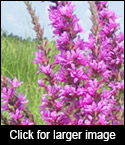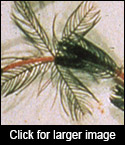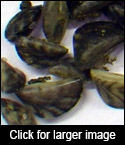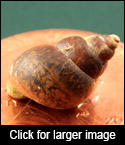Aquatic Invasive Species
 |
 |
 |
 |
 Purple Loosestrife (Lythrum salicaria)
Purple Loosestrife (Lythrum salicaria)
Growth Form – Purple loosestrife is an herbaceous, wetland perennial that is capable of producing millions of seeds in a single growing season.
Impacts - It can invade upland sites but has a preference for wetlands. It is found typically in ditches, wet meadows, ponds, marshes, river and stream banks and also lake shores.
Threats - Purple loosestrife displaces native aquatic vegetation and is extremely successful at creating monocultures. The dense stands are unsuitable habitat for wildlife and have no nutritional value for native wildlife.
Where – Numerous populations have been found on Leech Lake Reservation, particularly around Bowstring Lake.
Note - This photo is taken in Inger near the transfer station
 Eurasian Watermilfoil (Myriophyllum spicatum)
Eurasian Watermilfoil (Myriophyllum spicatum)
Growth Form – Eurasian watermilfoil is a submerged aquatic perennial that reproduces through fragmentation and runners.
Impacts - It invades lakes with no well established native aquatic plant populations.
Threats - Eurasian watermilfoil forms thick mats on the surface and thick underwater stands in lakes that are rich in nutrients and has the ability to crowd out native vegetation. It also makes it difficult to navigate through with boats.
Where – It has only been detected on Leech Lake, but it is capable of entering other bodies of water if attached to water equipment.
 Zebra Mussel (Dreissena polymorpha)
Zebra Mussel (Dreissena polymorpha)
Impacts - Zebra mussels are a threat to Lakes. In a single spawning season, a female can release one million eggs into the water column which are fertilized by sperm that is also released into the water column by males.
Threats - It is a small invertebrate that is the only freshwater mussel to attach unbiasedly to any hard surface. It is a filter feeder that can impact the food chain by filtering out plankton that larval fish rely on. It also threatens infrastructure by attaching to it in large numbers.
Where – Cass Lake, Lakes Winnibigoshish, Sand Lake, and all the adjoin waters are now designated as zebra mussel infested waters.
Note - These zebra mussels were taken from four boat lifts on Cass Lake.
 Faucet Snail (Bithynia tentaculata)
Faucet Snail (Bithynia tentaculata)
Impacts - Faucet snails are a threat to the certain waterfowl and potentially the ecosystem of lakes.
Threats - It is an aquatic snail that acts as host for three trematodes that can potentially cause mortality in waterfowl. It can also cause damage to the infrastructure.
Where -It has become quite abundant in areas of Winnibigoshish and Bowstring Lake.
Contact Us
DRM (218) 335-7400
| Name | Title | Phone |
| Mortensen, Steve | Fish, Wildlife & Plant Resources Program Director | 335-7421 |
| Katie Zlonis | Botanist/Invasive Species Program Manager | 335-7442 |
| Finn, Jon | Fish & Wildlife Field Specialist | 335-7424 |
| White, Gary | Assistant Hatchery Manager | 335-7424 |
| Robinson, Martin | Fish and Wildlife Technician | 335-7424 |















 Division of Resource Management
Division of Resource Management